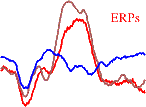


Ph.D., University of Wisconsin, 1980
rsimons@udel.edu
Professor 


Ph.D., University of Wisconsin, 1980
rsimons@udel.edu
![]()
![]()



Psychophysiological approaches to human emotion and cognition. Current studies involve the impact of specific media properties such as motion, color and sound on the emotion dimensions of valence and arousal. In addition to our long-standing interest in emotion-processing deficits such as anhedonia and arousal, our most recent studies use brain-potential (ERP) and reflex (startle) measures to explore executive function in subjects with anxiety disorders.
| Fiorito, E.R. & Simons, R.F. (1994) Emotional Imagery and Physical Anhedonia. Psychophysiology, 31, 513-521. | |
| Simons, R.F. & Perlstein, W.P. (1997). A Tale of Two Reflexes: An ERP Analysis of Prepulse Inhibition and Orienting. In P.J. Lang, R.F. Simons & M.T. Balaban (Eds.). Attention and Orienting: Sensory and Motivational Processes. Erlbaum: Hillsdale, NJ. | |
| Detenber, B.H., Simons, R.F. & Bennett, G.G. (1998). Roll 'em!: The Effects of Picture Motion on Emotional Responses. Journal of Broadcasting and Electronic Media, 21, 112-126. | |
| Roedema, T.M. & Simons, R.F. (1999). Emotion Processing Deficit in Alexithymia. Psychophysiology, 36, 379-387. | |
| Simons, R.F., Detenber, B.H., Roedema, T.M. & Reiss, J.E. (1999). Emotion-Processing in Three Systems: The Medium and the Message. Psychophysiology, 36, 619-627. | |
| Detenber, B.H., Simons, R.F., Roedema, T.M., & Reiss, J.E. (2000). The effects of color in film clips on emotional responses. Media Psychology, 2, 331-355. | |
| Perlstein,
W.P., Simons, R.F. & Graham,
F.K.
(2001).
Prepulse effects as a function of cortical projection system.
Biological Psychology. | |
| Simons, R.F., Graham, F.K., Miles, M.A. & Chen, X. (2001). On the Relationship of P3a and the Novelty-P3. Biological Psychology |
| Ginger Coman (B.A. Rutgers University) -- Sexual Harassment and the
Hostile Work Environment. Developed measure to identify males likely to participate in hostile work environment sexual harassment (Coman
& Simons, 1996). Current studies focus on differentiating men who are likely to commit HE sexual harassment from those more likely to engage in the "quid pro quo" form by examining the overt behaviors on the part of pre-tested males that achieve separation from women through exclusion, avoidance, or distancing in face-to-face interpersonal situations. A cooperative "game" situation will be used to provide the context for this face-to-face situation (Coman, 2002). | |
| Tom Roedema (B.A. Penn State University) -- Dysphoric Mood and Startle Modification. Subjects identified as dysphoric (high anhedonia or depression scores) show weaker linear relationship between emotional state (foreground slide valence) and reflex blink magnitude. Between-group difference most obvious when stimuli target a positive-valence state. Recent research involving emotion-processing in alexithymia has used facial EMG and traditional ANS measures (Roedema & Simons, 1997) to reveal deficits in emotion arousal. Dissertation studies employ regional EEG activity to explore both anhedonia and alexithymia (Roedema, 2002). | |
| Greg Hajcak (B.S. University of Pittsburgh) -- Cognitive and psychophysiological correlates of psychopathology; the relationship between Event-Related Potentials (ERPs) and Anxiety Disorders. Current research evaluates executive function in subjects with obsessive-compulsive tendencies (Hajcak & Simons, 2001) and other anxieties (Hajcak, McDonald & Simons, 2002) using an event-related brain potential known as Error-Related Negativity. |
![]()
 For
something almost as interesting
For
something almost as interesting